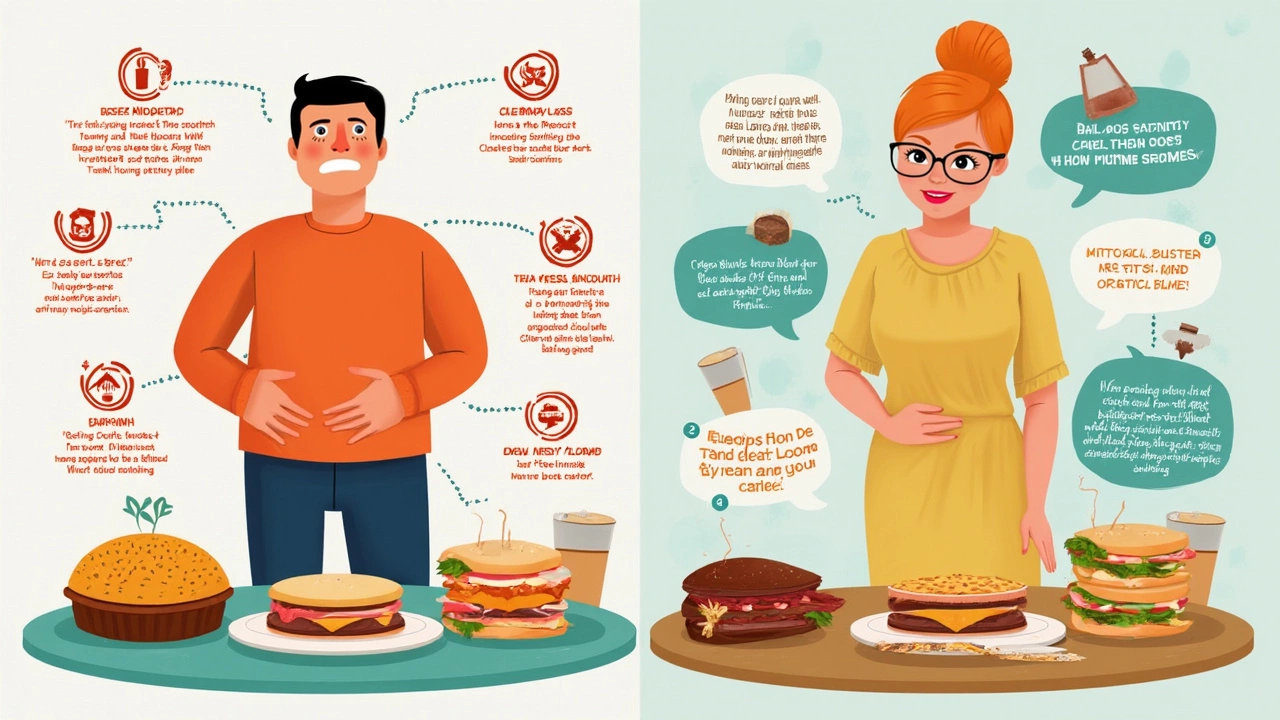Ever felt like your stomach just blew up like a balloon after a sandwich? That's what people often call a "gluten belly." It's not a scientific term, but if you feel bloated, gassy, or downright uncomfortable after eating bread, pasta, or cookies, this might ring a bell.
So, what’s really happening in your gut? For lots of folks, gluten—a protein found in wheat, barley, and rye—doesn’t play nice with their digestive system. It can make your belly puff up, make your jeans feel tight, or even leave you running to the bathroom.
Here’s the deal: gluten belly is super common among people with gluten sensitivity, celiac disease, or even those who just notice they feel better without gluten. If you've ever wondered whether that pizza night is causing the next day's tummy drama, you're not alone.
But the good news is, you don’t have to miss out on your favorite foods. There are easy swaps and simple kitchen hacks to help you ditch gluten without losing the flavor or the fun. Stick around, and you’ll grab some down-to-earth tips for keeping your belly happy and your meals delicious.
- What is Gluten Belly Exactly?
- How to Recognize the Symptoms
- Why Gluten Causes Trouble for Some
- Smart Food Swaps and Cooking Tips
- When to Get Professional Help
What is Gluten Belly Exactly?
So, what do people mean when they say gluten belly? It’s the nickname for that dreaded feeling of bloating, puffiness, or digestive chaos after eating foods with gluten. It’s not an official medical term, but just about anyone who’s dealt with it knows the feeling right away. You eat a bowl of pasta or a slice of regular pizza, and boom—your stomach suddenly feels like it’s got its own weather system brewing inside.
Gluten belly usually pops up in people with gluten sensitivity or celiac disease, but others who just don’t digest gluten well might get the same symptoms. Scientists know that gluten is a protein in wheat, barley, and rye, but our bodies don’t always handle it smoothly. When someone’s body can’t process gluten, it can lead to a variety of uncomfortable gut symptoms.
Here’s what happens in simple terms: gluten enters your digestive system, your body reacts (sometimes even causing mild inflammation), and you wind up feeling sluggish, bloated, or gassy. You might spot a swollen belly in the mirror, feel weirdly full after a normal meal, or even have bathroom troubles. And it’s not just in your head—studies found that up to 13% of people worldwide report issues when they eat gluten, even if they don’t have celiac disease.
| Common Foods With Gluten | Common Gluten-Free Alternatives |
|---|---|
| White and wheat breads | Rice bread, gluten-free sourdough |
| Pasta | Brown rice pasta, quinoa pasta |
| Cookies and cakes | Almond flour, oat flour treats |
| Beer | Gluten-free beer, cider |
If you suspect that your uncomfortable belly is tied to gluten, you’re not alone. Tons of people have switched to a gluten free lifestyle and noticed their symptoms get a lot better. Pinning down the cause can help you take back control of your gut and find foods that leave you satisfied, not swollen.
How to Recognize the Symptoms
So how do you know if you really have what's called gluten belly? It’s more than just an after-lunch bulge. The signs can show up fast—sometimes within an hour after eating something with gluten, though for some people it might take a little longer.
The main thing people notice is bloating. Your stomach feels bigger, tighter, and you might even look like you swallowed a soccer ball. But that’s not the only sign. Other common symptoms of gluten belly or gluten sensitivity include:
- Lots of gas (we’re talking burping or, yes, farting much more than usual)
- Crampy, sore belly that sometimes comes with sharp pain
- Feeling tired or heavy, almost like you need a nap after you eat
- Nausea or a queasy stomach
- Occasional diarrhea or, on the flip side, getting constipated
- Headaches or that brain-fog feeling where it’s tough to focus
If you have celiac disease, the symptoms can be even more dramatic—sometimes including vomiting, skin rashes, or ongoing weight loss. But for most folks dealing with gluten belly, it's mainly about that bloating, gas, and stomach pain.
Want a quick look at which symptoms pop up the most? Here’s what one survey of gluten-sensitive people found:
| Symptom | % of People Who Experience It |
|---|---|
| Bloating | 80% |
| Gas | 72% |
| Stomach pain | 68% |
| Diarrhea/Constipation | 60% |
| Headache/Brain fog | 35% |
Now here’s the tricky part: these symptoms can show up from other stuff too, like stress, certain medicines, or eating a giant burrito. To really figure out if gluten is the issue, you’ll want to keep track of what you eat and when the symptoms hit. A simple food journal can work wonders and help your doctor spot patterns.

Why Gluten Causes Trouble for Some
Ever wonder why some people can chow down on a big bowl of pasta and feel fine, but others end up with a gluten belly? It all comes down to how your body handles gluten. For some folks, gluten just doesn’t break down right in the gut, leading to a whole bunch of stomach problems.
There are three main reasons why gluten can mess with your stomach:
- Celiac disease: This is an autoimmune condition where gluten actually damages the small intestine. Only about 1% of the population has this, but it’s serious. Eating even a tiny amount of gluten can set off a big reaction.
- Non-celiac gluten sensitivity: Way more common, this means you don’t test positive for celiac, but you still get stomach pain, bloating, or even headaches after eating gluten. No one’s totally sure why this happens, but it’s real enough to make your day miserable.
- Wheat allergy: This is your immune system overreacting to proteins in wheat, which often includes gluten. It can cause classic allergy symptoms (like hives or trouble breathing) but can also hit your gut hard.
The Science Behind the Bloat: When your body struggles with gluten, it kicks off a reaction in your gut—sometimes inflammation, sometimes just plain irritation. Your immune system or gut bacteria might get involved, and the result is often gas and bloating that makes you want to unbutton your jeans within the hour.
| Condition | How Common? | Main Symptoms |
|---|---|---|
| Celiac disease | ~1% | Diarrhea, cramps, weight loss |
| Non-celiac gluten sensitivity | 6-7% | Bloating, fatigue, brain fog |
| Wheat allergy | Approx. 0.5-1% | Hives, swelling, sometimes nausea |
"For people who are sensitive to gluten, the symptoms may include not just bloating, but also headaches, tiredness, and joint pain," says Dr. Alessio Fasano, medical director at the Center for Celiac Research and Treatment.
The frustrating part? There’s no simple test for gluten sensitivity if you don’t have celiac. It’s all about how you feel after eating certain foods. So if pizza or bagels leave you aching and gassy, your body might just be telling you that gluten is the troublemaker.
Smart Food Swaps and Cooking Tips
You don’t have to give up taste to beat gluten belly. There are lots of solid swaps to keep your meals fun and safe for your gut health. These days, it’s even easier to find gluten-free options at the store, but knowing which ones to grab can make or break your kitchen game.
Here are some easy swaps that work for almost every meal:
- Bread: Try out gluten-free bread brands like Canyon Bakehouse or Schär. Or, go for a lettuce wrap if you want to skip bread completely.
- Pasta: Brown rice, quinoa, lentil, or chickpea pasta taste great and won’t leave you feeling heavy. They hold up well in sauces, too.
- Flour: Use almond flour, coconut flour, or oat flour (look for certified gluten-free oats) in pancakes, cookies, and muffins. Bob’s Red Mill and King Arthur make blends that work as a straight swap for regular flour in most recipes.
- Soy Sauce: Regular soy sauce has wheat, but tamari is a gluten-free version and tastes just as good.
- Snacks: If you’re into chips or crackers, look for ones made from rice, corn, or even beans. Popcorn (plain) is gluten-free by default, so that’s a win.
If you’re into baking, here are a few hands-on tips to get great results with gluten free recipes:
- Add an extra egg or a tablespoon of applesauce to keep baked goods moist. Gluten-free flours can dry out fast.
- Let your batter rest for 15–30 minutes before baking. That gives the flour time to soak up the liquids and improves the texture.
- Mix gently—overstirring can make things gummy.
Watch out for hidden gluten! Dressings, sauces, and even canned soups may sneak in wheat. Always double check the labels—look for "gluten free" or scan for sneaky ingredients like malt or modified food starch that aren't from corn or potatoes.
| Common Food | Easy Gluten-Free Swap |
|---|---|
| Pasta | Chickpea or rice pasta |
| Soy Sauce | Tamari |
| Crackers | Nut thins |
| Flour Tortillas | Corn tortillas |
| Breadcrumbs | Crushed rice cereal or gluten-free breadcrumbs |
If you’re eating out, don’t be shy—ask about gluten-free options. A lot of restaurants will happily swap out gluten-heavy items or have a separate menu for folks avoiding gluten.
Making these swaps can take a little trial-and-error at first, but you’ll get the hang of it fast. Your stomach—and your taste buds—will thank you.

When to Get Professional Help
If you keep dealing with a gluten belly—that achy, bloated feeling after eating bread or pasta—it might be time to talk to a doctor. While some gut grumbles are no big deal, certain symptoms mean you shouldn’t just brush things off.
These are red flags you should watch for:
- Bloating and pain that sticks around for days
- Unexplained weight loss
- Ongoing diarrhea or constipation
- Fatigue that doesn’t go away with rest
- Skin rashes, especially if they’re itchy or blistery
- Long-term iron deficiency or anemia
The thing is, gluten sensitivity and celiac disease can look alike but need very different treatment. Only a pro can run the right tests—like celiac blood panels or gut biopsies—to figure out what’s really going on. It’s not a good idea to just Google your symptoms and guess.
If you've been eating gluten-free for a while and still feeling awful, or if symptoms are getting worse, don’t wait. A doctor or a dietitian can help you spot hidden gluten in foods, recommend good supplements, and set up a plan that actually works for you. About 1 in 100 people worldwide has celiac disease, according to the Celiac Disease Foundation, and most don’t even know it.
For parents, if your kiddo is dealing with lagging growth, tummy aches, or mood swings along with a possible gluten belly, it’s a smart move to get them checked out sooner rather than later. Kids can show different signs compared to adults.
Bottom line: if your gut feels like a mess more often than not, reach out. That way, you can get the right answer, stop guessing, and get back to enjoying food again—maybe even some killer gluten free recipes.

